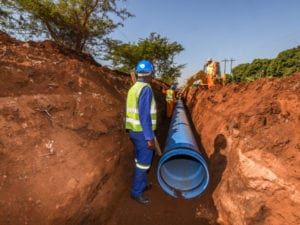Lightweight and requiring no specialised skills to install, TOM® 500 PVC-O is ideally suited for community projects in addition to providing longer-term savings for water utilities.
Sizabantu Piping Systems recently supplied the piping for the Driekoppies bulk water, Driekoppies reservoir and the Sibange bulk water pipeline projects for Ehlanzeni District Municipality and Nkomazi Local Municipality. For all phases, a range of material options were assessed by Lubisi Consulting Engineers and GMH Tswelelo Consulting Engineers for the size and pressure classes required. Materials considered were steel, ductile iron and TOM 500 PVC-O. The design specification called for a pipeline at least 630 mm in diameter. The decision was made to specify TOM 500 PVC-O, being the most cost-effective option.TOM 500 PVC-O is supplied in diameters up to 800 mm, so it comfortably met the varied scope requirements across the three projects. “A key advantage of TOM 500 PVC-O piping systems is that they have between 15% and 40% greater hydraulic capacity compared to alternative material systems with the same external diameter,” explains Greg Loock, director, Sizabantu Piping Systems. Sizabantu is the Southern African distributor for Spanish OEM Molecor, which is globally acknowledged as the pioneer of TOM 500 PVC-O, a major advancement on industry-standard PVC materials. This is because TOM 500 PVC-O’s molecular orientation reduces the thickness of the pipe wall, giving TOM 500 PVC-O pipes a greater internal diameter and flow section.Materials lose their mechanical properties when they are subjected to strain over a long period of time. This characteristic, known as creep, appears to a far lesser extent in TOM 500 PVC-O than in conventional plastics, providing better properties over the long term. TOM 500 PVC-O is also exceptionally resistant to fatigue and has a very good chemical resistance, much like conventional PVC.
Maintenance cost savings Going the ductile iron or steel pipe route would have required the mandatory installation of cathodic protection. This prevents premature structural failure caused by stray electricity currents, especially where pipelines are located near railway tracks or overhead power lines. Although essential, the downside to cathodic protection is that it typically costs around 12% to 27% of the overall cost of the pipeline. It also requires regular maintenance to be effective. That poses additional challenges for today’s cash-strapped municipalities, which also continue to experience shortages of technically skilled personnel. Either way, failure to protect or maintain the pipe will result in immediate corrosion. This is evident in the continuous leaking of metallic pipelines across South Africa, which contributes to increased non-revenue water losses and places a severe strain on an already water-scarce environment. “TOM 500 PVC-O is clearly a highly viable alternative,” points out Loock. “Providing a design life of at least 100 years, TOM 500 PVC-O systems don’t require coating or linings and require minimal maintenance. TOM 500 PVC-O allowed the engineers to design a pipeline within budget.” The reservoir phase was the largest of the three pipeline projects and comprised 6 100 m of TOM 500 PVC-O. Sizabantu supplied TOM 500 PVC-O PN 16 and PN 20 sections for Sibange, and TOM 355 PVC-O PN 16 for the Driekoppies bulk water component. On all phases, ease of installation has enabled the contractor to use local labourers and complete the project in the shortest time possible. TOM 500 PVC-O complies with SANS 16422 and is manufactured locally by Molecor South Africa at the company’s state-of-the-art manufacturing facility in Richards Bay, KwaZulu-Natal. To date, Sizabantu has sold more than 4 000 000 metres throughout Southern Africa. “TOM500 PVC-O is undoubtedly a world-class product and has enabled municipalities and water authorities to extend the life of their bulk water pipelines,” Loock concludes.







